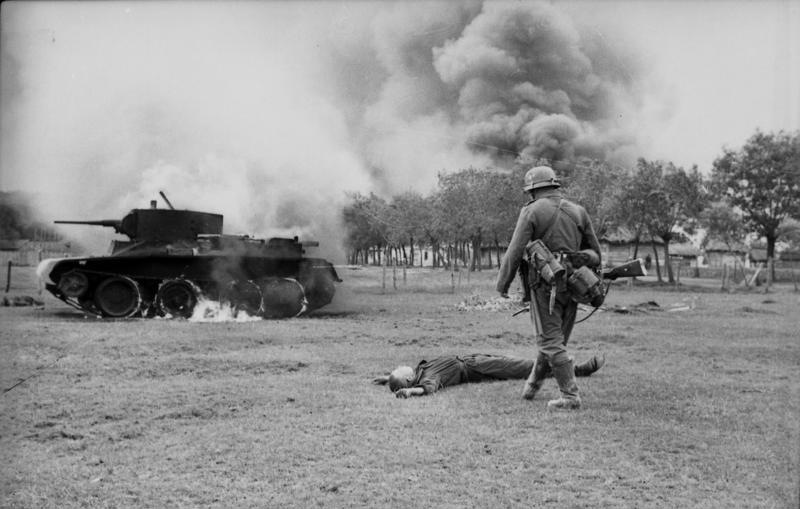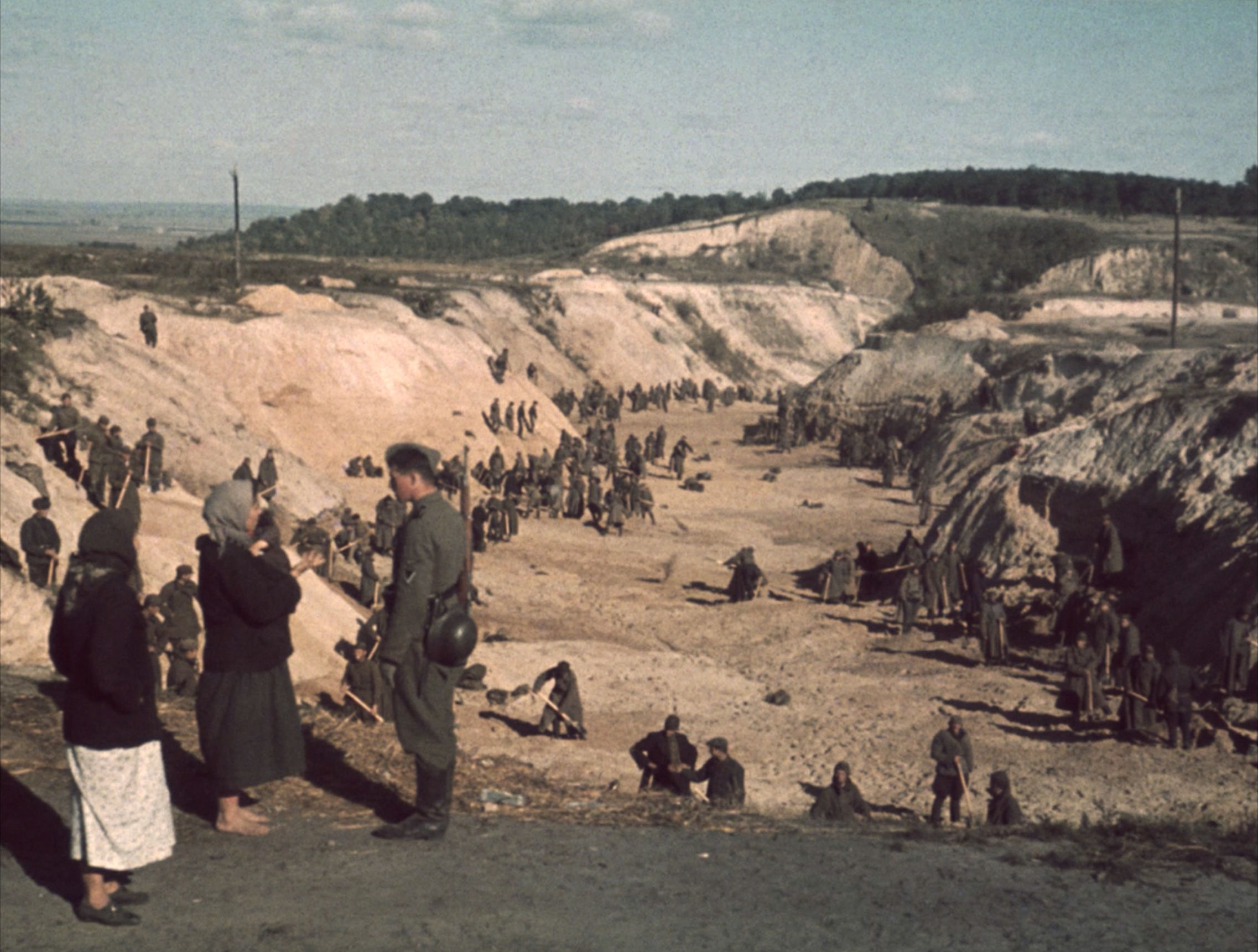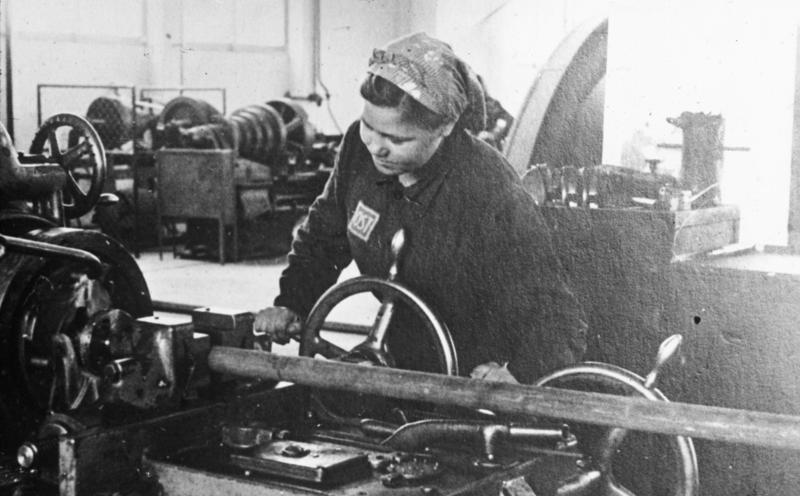| Defiant Russia:
Ukraine at War
By Mike Bennighof, Ph.D.
February 2023
Ukraine’s geographic position, her agricultural and mineral resources, and her newly-established heavy industry all assured that she would be a battlefield during the Second World War. The Molotov-Ribbtentrop Agreement sealed in late August 1939 assigned most of Polish-ruled Western Ukraine to the Soviet Union, including large swathes of territory that had never been under Imperial Russian rule.
Soviet troops rolled into Western Ukraine on 17 September 1939, after Poland had already suffered severe defeats at German hands and the end of the campaign was clearly in sight. Even so, the Polish Army continued to resist until 6 October 1939, when the last organized major combat unit surrendered to the Germans.

The despoilers of Poland congratulate one another.
The Soviets wasted little time incorporating their conquest into the Ukrainian Soviet Socialist Republic; in an election held on 22 October for a new People’s Assembly, of 4.7 million eligible voters, 4.4 million cast ballots and 4 million of those voted for the Communist slate. The new Assembly promptly requested to join the Ukrainian SSR. Not surprisingly, the Supreme Soviet granted the request on 1 November.
Western Ukraine’s new rulers slowly brought the region in line with the rest of the Ukrainian SSR. Labor unions, independent political parties and other cultural organizations were dissolved, their leaders imprisoned or deported to Siberia. The churches – Orthodox and Uniate Catholic – remained open, but now had to pay rent on their buildings, and pressure steadily mounted on them as they lost their role in education and as registrars or births, marriages and deaths. Farms began to be collectivized, printing and publishing ceased, and private schools closed. All Poles who had entered the area after Polish independence were rounded up and shipped off to Siberia; many Jewish businessmen joined them.
Throughout 1940, the pace increased. By the time the Germans invaded in June 1941, as many as 400,000 people from Western Ukraine had been exiled to Siberia or Soviet Central Asia. Initially the invaders had emphasized the Ukrainian language at the expense of Polish; now government and media moved more and more toward Russian. Thousands fled into German-occupied Poland, where a small slice of Ukrainian-populated land had fallen under the twisted cross. The Germans allowed Ukrainian cultural – though not political – activity to the extent that it undermined Polish culture, and allowed publishing in the Ukrainian language within those non-political parameters. The small Ukrainian battalion that marched into the occupied territories with the Germans was quickly disbanded.
While the Germans forbade Ukrainian nationalism within their own sphere, they were willing to exploit it as a weapon against the Soviets. The Organization for Ukrainian Nationalism found a home in German-occupied territory, and faced with an existential crisis for Ukraine and Ukrainians, almost inevitably fell into schism. Older members sought to create a Ukraine ruled by a strongman with the trappings of democracy, while younger members professed open admiration for Hitler and Mussolini.
In early 1941, as planning went forward for the German sneak attack on the Soviet Union, German Military Intelligence (the Abwehr organization) formed two small battalions of Ukrainian exiles. Initially these should have been just one unit, but factionalism within the OUN made that impossible. They entered Ukraine in the wake of the leading German divisions, seeing very little combat themselves.
At the time of the German invasion, the Soviet NKVD held about 150,000 prisoners of all description (criminal as well as political) in its prisons in Western Ukraine. Over the course of the war’s first eight days they massacred up to 40,000 prisoners in their cells or in the prison basements. Most of those killed were Ukrainian nationalists, as deportations to the East had not been completed. Some of those killed were Polish, some Jewish, and some simple criminals of all ethnic description.

Along Ukraine’s western frontier, the Red Army could not stop the invaders.
When the Germans arrived, they immediately picked up where the NKVD had left off, murdering up to 35,000 Jews in the last days of June and first days of July 1941. Two Special Action Groups of the SS militia – about 3,000 men between them – followed the German armies into Ukraine, with the task of eliminating Jews, Gypsies and communists. Additional murderers came from the Order Police battalions and Armed SS militia units assigned to Ukraine. Regular Army units assisted on occasion as well, with the 1st Mountain Division setting the tone within days by helping SS militiamen murder Jews in Lviv.
One faction of OUN – the admirers of fascism – declared an independent Ukraine on the last day of June. But the Germans had not invaded the Soviet Union in order to free its subject peoples. In July, the German occupation authorities in Poland began arresting the OUN’s leadership, and on 16 July Adolf Hitler laid out his intentions for Ukraine. There would be no independent or even autonomous Ukrainian state; the racially-inferior Ukrainians, even lower on the scale than the Russians, would have no voice at all in their country’s affairs and would be denied the right to bear arms.
Much of western Ukraine would be governed by the occupation authorities in Warsaw, with a slice of territory going to Romania as compensation for Romania’s loss of Transylvania to Hungary. This did not satisfy the anger of Romanian nationalists or cool their anti-Hungarian ardor. The remainder of Ukraine would be administered from Rivne in Western Ukraine as the Reichskommissariat Ukraine, led by Erich Koch, head of the Nazi Party in East Prussia. “No German soldier,” Koch declared, referring to Ukrainians, “will ever die for that n***** people,”
German armies, assisted by a large Romanian contingent and a token Hungarian force, overran almost all of Ukraine by late 1941. Encirclement battles around Kyiv led to the loss of 700,000 of Soviet troops, most of them captured. Kyiv fell on 19 September with very little damage, despite Adolf Hitler’s 12 August 1941 directive that the city be razed. Ten days after the Ukrainian capital’s capture, members of the Order Police began to murder Jews at Babi Yar outside Kyiv, killing over 33,000 people, assisted by SS militia and Ukrainian Auxiliary Police (Schutzmannschaft in German), most of the latter former members of OUN.

Babi Yar, 1 October 1941: Soviet prisoners bury the dead. Russians bombed the Babi Yar Memorial in February 2022.
During the first eight months of the Great Patriotic War, the Germans captured 3.9 million Soviet prisoners of war, of whom about 1.3 million were Ukrainian. By the close of those eight months, only 1.1 million POWs remained alive, with starvation the chief weapon of extermination followed closely by disease.
Official German policy called for the systematic starvation of Ukraine’s population and its replacement by ethnic German settlers (except for attractive young women with blonde hair and blue eyes, who would be Germanized). Germany would not starve, as it had in the First World War – according to Hitler, any food shortages in Germany would be made good by removing food supplies from the occupied Soviet Union, chiefly Ukraine.
That didn’t work out as planned. The Germans extracted only a fraction of the grain and other foodstuffs they had hoped to loot; Ukraine actually produced grain surpluses in 1942 and 1943, but the German forced requisitions failed to collect this bounty in the face of Ukrainian passive resistance. Contributing to the failure, individual German soldiers and officers diverted much of what they did seize into packages they shipped home to their own families.
German troops had been greeted in many rural districts as liberators, but quickly dispelled any lingering goodwill through systematic and often casual brutality. Despite the fervent hopes of some peasants, they did not break up the collective farms, which the occupiers saw as a more effective means to extract agricultural produce. They did re-name them, calling them “communal farms” and pretending that the farmers actually owned the land, but that fooled no one. A lack of tractors and farm animals – requisitioned by the Germans or simply shot and left to rot in acts of vandalism – increased the need for farm workers, even as the workers themselves disappeared.
German attempts to revive Ukraine’s heavy industry and mining sectors made no progress, either. Ukraine’s miners dug out 76 million tons of coal in 1940. In 1942, they produced 2.2 million tons, and the occupiers had to ship coal from Germany to Ukraine just to support their administration and garrison. With many workers deported to Germany to work in factories there or as maids, nannies and gardeners, and many skilled workers having been murdered by the Germans, no one was left to operate the mines and factories. The riches of Ukraine would not help feed the Nazi war machine.
Not least among the factors contributing to those twin failures, the Germans had deported 2.2 million Ukrainians to Germany to work in armaments factories and in agriculture; about 29 percent of all forced laborers dragged to Germany were Ukrainian. More than half of them were women, averaging 20 years of age. By 1942 the Nazis had introduced conscription: all Ukrainians aged 18 to 20 were required to work in Germany for two years. The occupiers roamed the countryside, abducting able-bodied people and shipping them off to labor for Volkswagen, Siemens and Daimler-Benz.

A Ukrainian woman enslaved by I.G. Farben. The OST tag could not be removed on penalty of death.
German investors flocked to Ukraine, National Socialist vultures gobbling up farmland, buildings and industries sold off by Koch’s administration or simply given away in exchange for rather open bribes. German settlers arrived as well: even as the war turned against the Germans, newly-constructed villages sprang up to fill the void left by mass murder and starvation. Ethnic Germans from the Balkans and Austrian residents of South Tirol were to be moved to Ukraine, while a private venture in the Netherlands signed up ethnically pure Dutch settlers for the new frontier.
Re-opening Ukraine’s churches, shuttered under the Soviets, gained the occupiers some support in among the peasantry. In December 1941, Koch declared that Ukrainians had only one freedom: the freedom of religion. While their people suffered and died, and cried out for comfort, for leadership, the Ukrainian bishops devoted their energies to a bitter debate over the church’s status as autonomous (reporting to the Patriarch of Constantinople) or autocephalous (essentially independent).
The Germans reserved the sharp edge of their cruelty for the cities, seen as the home of Bolsheviks, intellectuals and of course Jews. Peasants were forbidden to bring food to the cities, and city-dwellers were not allowed into the countryside in search of food. Kyiv’s population numbered 850,000 in June 1941. When the Red Army liberated the capital in November 1943, it had fallen to 50,000. In Kharkiv, approximately 80,000 residents died of starvation alone during the occupation. Odesa lost 400,000 of its 600,000 pre-war residents.
Approximately 1.8 million Jews lived in Ukraine in June 1941. About 85,000 survived the war. By late 1941, as the Special Action Groups and Order Police began to run out of Jews to murder, they turned on ethnic Ukrainians, starting with nationalist intellectuals. That definition would be continually stretched, eventually including charity workers and consumer advocates. As resistance grew, the occupiers instituted a policy of collective responsibility, massacring entire villages in retaliation for partisan activity nearby. Estimates of deaths among non-Jewish Ukrainians vary widely, but at least four million of them perished under Nazi occupation. Ukraine’s population had totaled 41 million in January 1941; in January 1945 it had fallen to 27 million.
A later failed fascist invader would accuse all Ukrainians of collaboration with the Germans and with harboring Nazi sympathies. And while that’s simply not true of the majority of the population, despite the occupation’s brutality the Armed SS militia recruited 30,000 young Ukrainian men for their “Galicia” division, and another 35,000 joined the Auxiliary Police – the men who committed the lion’s share of the Holocaust in Ukraine. By contrast, approximately 250,000 Ukrainians fought the occupiers with partisan units. About 3.2 million Ukrainians served in the Red Army during the war; of those, almost exactly half died.
Following their July 1943 victory at Kursk, the Red Army steadily pushed the Germans out of Ukraine. They liberated Kharkiv in August 1943 and Kyiv in November, though it would take until October 1944 before all of pre-war Ukraine was free of the invaders.
You can order Defiant Russia (Playbook Edition) right here.
Sign up for our newsletter right here. Your info will never be sold or transferred; we'll just use it to update you on new games and new offers.
Mike Bennighof is president of Avalanche Press and holds a doctorate in history from Emory University. A Fulbright Scholar and NASA Journalist in Space finalist, he has published an unknowable number of books, games and articles on historical subjects.
He lives in Birmingham, Alabama with his wife, three children and his dog, Leopold.
Want to keep Daily Content free of third-party ads? You can send us some love (and cash) through this link right here.
|
